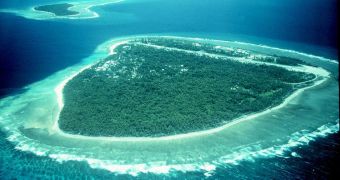Scientists have demonstrated in a new study of coral reefs that the area of the upper ocean where deep cold waters mix with warm surface waters is getting shallowed. The region is called the thermocline.
The new investigation was carried out in the western Pacific Ocean, on tropical coral reefs, the team behind the work says. This is the first time such a phenomenon is demonstrated in a study.
Climatologists and climate modelers have drawn attention for many years that this may happen, but thus far actual measurements to prove them wrong or right have been missing.
The thermocline is moving because global warming and climate change are exerting a nefarious influence on ocean circulation patterns bellows the surface of the world's oceans.
“Over several decades, specifically since the mid- to late-1970s, the records show that the mean depth of the thermocline has been getting shallower,” says expert Branwen Williams.
She was a part of the research while a PhD students at the Ohio State University (OSU), but she now holds an appointment as a postdoctoral student at the University of Toronto in Ontario.
The expert concedes that part of the thermocline's rise may have been prompted by an El Nino-like atmospheric phenomenon called the Pacific Decadal Oscillation (PDO), which manifests itself through prolonged patterns of natural variability.
For example, when the thermocline shifted in the 1970s, this was correlated to a shift from the negative to the positive phases of the PDO, says OSU research team member Andrea Grottoli.
“We think the thermocline rose when the PDO shifted, that it was a cumulative effect of both the natural variability of the PDO plus the warming global temperatures,” the scientist explains.
Analyzing what goes on way below the surface of the ocean is fairly complex, because only direct measurements can penetrate into the areas, and they are very expensive and complex to conduct.
In order to study deep ocean phenomenon more easily, Williams and the study team turned to analyzing Gorgonians, which are a form of soft, flexible corals that grow offshore the island nation of Palau in the western Pacific Ocean.
“These corals 'sway' with the current underwater like trees in the wind,” Grottoli explains, quoted by Our Amazing World.
“Since they aren't restricted to shallow and warmer surface waters like other tropical corals, they provide an opportunity to reconstruct a picture of subsurface ocean circulation in a region,” the scientist says.
“Climate modelers looking at how the Pacific might respond to global warming have predicted that the atmospheric patterns in the tropical Pacific would weaken, and if that happened, you would expect the thermocline to get shallower in the western tropical Pacific,” Williams adds.
“Our data are some of the first proxy data to support what the modelers have been predicting,” the expert argues. Details of the work will appear in an upcoming issue of the esteemed journal Geophysical Research Letters.

 14 DAY TRIAL //
14 DAY TRIAL //